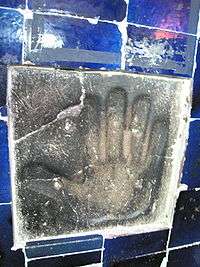Safi-ad-din Ardabili
Sheikh Safi-ad-din Is'haq Ardabili (of Ardabil) (1252–1334) (Persian: شیخ صفیالدین اسحاق اردبیلی Shaikh Ṣāfī ad-Dīn Isḥāq Ardabīlī), was the Kurdish[2][3][4] and Sunni[1] Muslim eponym of the Safavid dynasty, founder of the Safaviyya order, and the spiritual heir and son in law of the great Sufi Murshid (Grand Master) Sheikh Zahed Gilani, of Lahijan in Gilan province in northern Iran. Most of what we know about him comes from the Safvat as-safa, a hagiography written by one of his followers.
Safi-ad-din Ardabili | |
|---|---|
 | |
| Personal | |
| Born | 1252 |
| Died | 1334 (aged 81–82) |
| Religion | Islam, Sunni (Shafi'i)[1] |
| Senior posting | |
| Predecessor | Sheikh Zahed Gilani or Taleshi (Under the Zahediyeh order) |
| Successor | Sadr al-Dīn Mūsā (Son) |
| Part of a series on Islam Sufism |
|---|
|
List of sufis |
|
|

Lineage
Safi-ad-din was of Kurdish origins. According to Minorsky, Sheykh Safi al-Din's ancestor Firuz-shah was a rich man, lived in Gilan and then Kurdish kings gave him Ardabil and its dependencies. Minorsky refers to Sheykh Safi al-Din's claims tracing back his origins to Ali ibn Abu Talib, but expresses uncertainty about this.[5]
The male lineage of the Safavid family given by the oldest manuscript of the Safwat as-Safa is:"(Shaykh) Safi al-Din Abul-Fatah Ishaaq the son of Al-Shaykh Amin al-din Jebrail the son of al-Saaleh Qutb al-Din Abu Bakr the son of Salaah al-Din Rashid the son of Muhammad al-Hafiz al-Kalaam Allah the son of Javaad the son of Pirooz al-Kurdi al-Sanjani (Piruz Shah Zarin Kolah the Kurd of Sanjan)"[6] similar to the ancestry of Sheykh Safi al-Din's father-in-law, Sheikh Zahed Gilani, who also hailed from Sanjan, in Greater Khorassan.

Ascension as Murshid
Sheikh Safi al-Din inherited Sheikh Zahed Gilani's Sufi order, the "Zahediyeh", which he later transformed into his own, the "Safaviyya". Sheikh Zahed Gilani also gave his daughter Bibi Fatemeh in wedlock to his favorite disciple. Sheikh Safi al-Din, in turn, gave a daughter from a previous marriage in wedlock to Shaikh Zahed Gilani's second-born son. Over the following 170 years, the Safaviyya Order gained political and military power, finally culminating in the foundation of the Safavid dynasty which established control over parts of Greater Iran and reasserted the Iranian identity of the region,[7] thus becoming the first native dynasty since the Sasanian Empire to establish a national state officially known as Iran.[8]
Poetry
Sheikh Safi al-Din has composed poems in the Iranian dialect of old Tati.[9][10] He was a seventh-generation descendant of Firuz-Shah Zarrin-Kolah, a local Iranian dignitary.[11]
Only a very few verses of Sheikh Safi al-Din's poetry, called Dobaytis (double verses), have survived. Written in old Tati and Persian, they have linguistic importance today.[12]
See also
Notes
- Shaykh Safi al-Din Ardabili, Oxford Reference
- Richard Tapper, Frontier nomads of Iran: a political and social history of the Shahsevan, Cambridge University Press, 1997, ISBN 9780521583367, p. 39.
- "EBN BAZZĀZ – Encyclopaedia Iranica". www.iranicaonline.org.
- Muḥammad Kamāl, Mulla Sadra's Transcendent Philosophy, Ashgate Publishing Inc, 2006, ISBN 0754652718, p. 24.
- Minorsky Vladimir, The Turks, Iran and the Caucasus in the Middle Ages. Preface by J.A. Boyle. Variorum Reprints, London 1978; page 517-518
- Z. V. Togan, "Sur l’Origine des Safavides," in Melanges Louis Massignon, Damascus, 1957, III, pp. 345-57
- RM, Savory (1980). Iran under the Safavids. Cambridge: Cambridge University Press. p. 3.
Why is there such confusion about the origins of this important dynasty, which reasserted Iranian identity and established an independent Iranian state after eight and a half centuries of rule by foreign dynasties?
- Shahbazi, Alireza Shapur (2005). "The History of the Idea of Iran", in Vesta Curtis ed., Birth of the Persian Empire. London: IB Tauris. p. 108.
Similarly the collapse of Sassanian Eranshahr in AD 650 did not end Iranians' national idea. The name "Iran" disappeared from official records of the Saffarids, Samanids, Buyids, Saljuqs and their successor. But one unofficially used the name Iran, Eranshahr, and similar national designations, particularly Mamalek-e Iran or "Iranian lands", which exactly translated the old Avestan term Ariyanam Daihunam. On the other hand, when the Safavids (not Reza Shah, as is popularly assumed) revived a national state officially known as Iran, bureaucratic usage in the Ottoman empire and even Iran itself could still refer to it by other descriptive and traditional appellations
- "The Iranian Language of Azerbaijan" E. Yarshater, Encyclopædia Iranica
- Ehsan Yarshater, Encyclopædia Iranica, Book 1, p. 240.
- Barry D. Wood, The Tarikh-i Jahanara in the Chester Beatty Library: an illustrated manuscript of the "Anonymous Histories of Shah Isma'il", Islamic Gallery Project, Asian Department Victoria & Albert Museum London, Routledge, Volume 37, Number 1 / March 2004, Pp: 89 - 107.
- "Ali Qapu Gate Unearthed in Sheikh Safi Domed Mausoleum". www.payvand.com.
Literature
- Monika Gronke, Derwische im Vorhof der Macht: sozial- und wirtschaftsgeschichte Nordwestirans im 13. und 14. Jahrhundert, Wiesbaden 1993
- Mazzaoui, Michel, The Origins of the Safavids: Shi'ism, Sufism, and the Gulat, Wiesbaden, West Germany: F. Steiner, 1972.
External links
- http://www.irantourismcenter.com/?page_id=7130
- Square Kufic inscription on Sheikh Safi al-Din's tomb
- Sheikh Safi al-Din Ardabili's Mausoleum Virtual Tour
Safi-ad-din Ardabili | ||
| New title | Leader of the Safaviya Order 1293–1334 |
Succeeded by Sadr al-Dīn Mūsā |